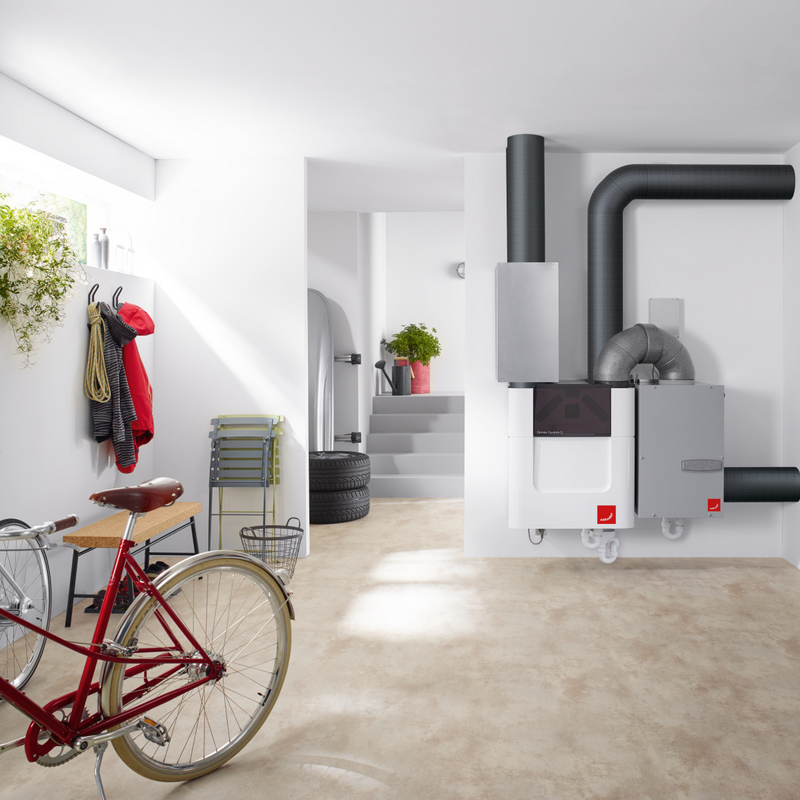
Heat Recovery & Ventilation Systems Selector
Find the perfect heat recovery ventilation solution for your needs. For the ideal indoor climate.
A high-efficiency heat exchanger transfers thermal energy from the outgoing air to the incoming air to support a stable indoor climate.
Heat recovery systems improve energy efficiency by using excess heat (that would otherwise be lost) to warm the incoming fresh air. Common examples include heat recovery ventilation (HRV) or enthalpy recovery ventilation (ERV) systems. These technologies reduce energy consumption, lower utility costs, and contribute to a building’s overall sustainability.
Also known as Mechanical Ventilation with Heat Recovery (MVHR), these systems are common in passive houses and other low-energy buildings. Designed for continuous operation, modern MVHR units balance supply and extract air efficiently across seasons, with minimal maintenance and adaptability to different ventilation needs.
The cost of a heat recovery ventilation (HRV) system depends on your home’s size, the system type, and installation complexity. Although the upfront cost can seem high, HRV systems offer long-term savings by recovering heat and reducing the need for cooling. Features like summer bypass and cold recovery enhance efficiency and comfort year-round.
For a quick cost indication, try the Zehnder Heat Recovery & Ventilation Systems Selector. For tailored advice and system design, Zehnder’s experts can help you find the right MVHR system for your needs and budget. All MVHR systems are supported by expert advice and after-sales care, ensuring long-term performance and efficiency.



Standard ventilation systems remove stale air and replace it with fresh outdoor air, but they lose the thermal energy from the indoor air in the process. Heat recovery ventilation systems, on the other hand, use a heat exchanger to transfer warmth from the outgoing air to the incoming fresh air, significantly reducing heat loss. This process improves energy efficiency and helps maintain a more stable indoor temperature, especially in homes built to high insulation standards.
HRV (Heat Recovery Ventilation) and MVHR (Mechanical Ventilation with Heat Recovery) refer to the same type of system. MVHR is more commonly used in technical standards or architectural plans, while HRV is often used in residential and commercial marketing. MVHR systems are a type of mechanical ventilation heat recovery solution commonly used in energy-efficient residential and commercial buildings. MVHR systems are designed to provide balanced mechanical ventilation while recovering heat from extracted air, helping to improve indoor air quality and energy efficiency. ERVs (Enthalpy Recovery Ventilators) differ slightly by also transferring moisture, which helps prevent dry indoor air during winter.
When comparing HRV systems, key factors include heat recovery efficiency, air volume capacity, filter performance, noise levels, and compatibility with your building layout as well as local standards and regulations. It's also important to consider long-term support, ease of maintenance, and the manufacturer’s experience in the field. Zehnder is one of the most established and trusted names in the industry, offering high-efficiency systems that meet building regulations and deliver significantly improved air quality and energy performance compared to standard ventilation options.
Yes, HRV systems can be installed in existing homes as part of a retrofit, although the installation may be more complex than in new buildings. Compact units or single room heat recovery options are often ideal for renovations, where full ducting may not be possible. Zehnder offers a range of solutions tailored to different building types, including decentralised systems designed specifically for retrofitting individual rooms without major construction work.
Yes, HRV systems help reduce the build-up of indoor CO₂ by continuously replacing stale air with fresh outdoor air. In spaces with high occupancy or poor natural ventilation, CO₂ levels can rise quickly and affect concentration and wellbeing. Reducing carbon dioxide levels in buildings - mainly caused by humans breathing - is an important task to help to improve indoor air quality. A properly designed mechanical ventilation system with heat recovery ensures a steady supply of oxygen-rich air, which improves indoor air quality, reduces indoor pollutants, and supports a healthier, more comfortable living environment.
Yes, all ventilation systems help remove indoor humidity, which reduces the risk of mould and damp. HRV systems are particularly effective due to their continuous extraction of moist air from wet rooms like bathrooms and kitchens, and the supply of dry, filtered air into living spaces. They help maintain a balanced indoor climate. This prevents condensation on windows and walls — one of the main causes of mould growth — and contributes to healthier air in well-sealed, energy-efficient buildings.
Many modern HRV systems are compatible with smart home technologies and building management systems. Depending on the model, they can be controlled via apps, wall-mounted interfaces, or integrated into automation platforms like KNX or Modbus. Zehnder’s ComfoAir Q series, for example, offers advanced digital control options, including remote access and automatic adjustments based on indoor air quality, temperature, and humidity sensors.
A high-quality HRV system can last 15 to 20 years with regular upkeep. Key components like fans and heat exchangers are designed for long-term use, especially in well-maintained environments. Most manufacturers offer warranties between 2 and 5 years, covering major components. Zehnder systems are built for durability and backed by reliable support, offering long service life with low maintenance requirements — a strong long-term investment in both comfort and energy efficiency.
Regular maintenance is essential to keep an HRV system running efficiently and to maintain indoor air quality. At home, users can clean or replace filters every 3 to 6 months, check air intakes for obstructions, and keep grilles and vents dust-free. Periodically inspecting the condensate drain and cleaning accessible parts of the unit can also help. Professional maintenance is recommended every 1 to 2 years to check airflow rates, clean the heat exchanger, and ensure sensors, fans, and control systems are functioning properly.
Living rooms, bedrooms, and other habitable rooms benefit most from the supply of fresh, filtered air, while moisture-prone spaces like bathrooms, kitchens, and utility rooms are typically the focus for air extraction. This balance ensures stale air is removed from the most humid areas while delivering fresh tempered air to the spaces where people spend the most time. This layout improves overall air circulation and helps meet building regulations for indoor air quality and energy efficiency.
By recovering heat that would otherwise be lost through standard ventilation, HRV systems reduce the need for heating and cooling — which helps lower energy consumption and ongoing energy costs. Over time, this can lead to noticeably reduced energy bills, especially in airtight or well-insulated homes. Other ventilation systems may also contribute to lower energy use, but without heat recovery, their savings potential is significantly lower.
HRV systems are especially effective in wet rooms like bathrooms, kitchens, and utility spaces where moisture levels are high. These are the areas where extracted air is typically drawn from. The recovered heat is transferred to incoming supply air, which is delivered to living spaces like bedrooms and living rooms, maintaining comfort throughout the home.
Yes, HRV systems are widely used in both passive house construction and energy-conscious office buildings. These systems help meet strict building regulations by providing continuous ventilation, managing indoor humidity, and supporting energy efficiency across different temperatures and climate zones.
HRV systems can provide a more energy-efficient and balanced solution compared to background ventilators or basic extract ventilation setups. Unlike extract-only systems, they also recover heat from exhaust air and supply fresh, filtered air — helping to maintain indoor comfort and reduce energy use.
Yes, modern HRV systems are designed to operate year-round, adjusting to both heating and cooling demands in changing seasons. Features like cold recovery and summer bypass allow them to handle different temperatures efficiently, ensuring that the system works to provide consistent air quality and comfort in all conditions.
HRV systems are designed to complement your existing heating system by reducing lost heat through controlled ventilation. They work particularly well alongside a heat pump or ground source heat pump, where preserving low-grade heat is essential. By recovering warmth from the outgoing air, HRV systems help reduce the demand on your primary heat source, improving energy efficiency across the whole system.
Moisture recovery creates a healthier, more comfortable indoor environment all year long. During winter, it prevents the air from becoming too dry, while in summer, it helps regulate humidity levels that would otherwise make spaces feel even warmer. The result: an ideal indoor climate, season after season.
It’s a common misconception that windows can’t be opened once a system is installed. In reality, opening them occasionally is fine. You just temporarily lose some of the system’s benefits, like heat recovery and filtered fresh air.
General Request
Contact FormOffer Request
Contact FormService & Spare Parts Request
Contact FormGeneral request
+49 (0) 123 45 67Offer Request
+49 (0) 123 45 68